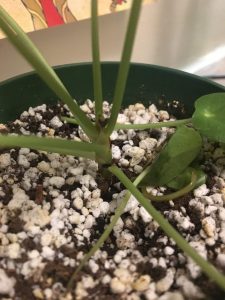
I recently inherited a younger pilea from a friend; and this is my first time owning plants and I’m trying my best to take care of them. She used to water it every three days, and I’m watering it every four days because my apartment isn’t as dry. There was a time that I accidentally watered it one day after the other, and I waited a week to water it another time. The plant is on my top bookshelf and to check if it needs water I take it down and stick the top of my finger in the soil. It gets plenty of non direct sunlight as my apartment is west facing. Now I’m noticing that perfectly healthy looking leaves are just falling off, and some of the new growth is coming in black. What am I doing wrong?
Thank you for writing about your newly-adopted Peperomia plant, the Pilea peperomioides, otherwise called Pilea. This now-popular houseplant, native to China, is considered an easy-to-grow-plant. If this is the case, why is your plant suffering?
Your photo shows the plant soil and stem, and a few fallen leaves are visible. If there are still some leaves intact, then the plant should be able to photosynthesize, and hopefully start new growth. The black that you see is, unfortunately, very likely the result of a fungus forming due to root and stem rot.
Your friend may already have initiated the problem by “watering every three days”, and you unwittingly “watered it one day after the other”. The test for when to water is based on your personal assessment of the soil moisture, and not the number of days between watering. Unfortunately for most house plant gardeners, it is not that simple! The trick is to allow the plant to dry out between watering. You are correct: human finger tips are very, very sensitive, and so physically testing for moisture with your finger a few inches down into the soil, is the best. Also the indirect light it gets is likely sufficient. However, in the case of you Pilea, our advice would be to plan a re-potting exercise, to gently remove the root system from the pot and carefully inspect the roots, removing any rotten sections. Dispose of the infected plant matter, and the soil. Let the roots get some air, and dry a bit, then re-pot in a loose, well-draining potting medium, into a pot with one or more good drainage holes, and set into a larger pot, or saucer, so that you can have visual proof that water is escaping freely from the planting medium.
The business of raising houseplants can be very tricky, since they’re obliged to live in the environments we give them.
So you know that you are not alone, especially with your first experience with growing houseplants, here is another Toronto Master Garden entry for your further research: Pilea

